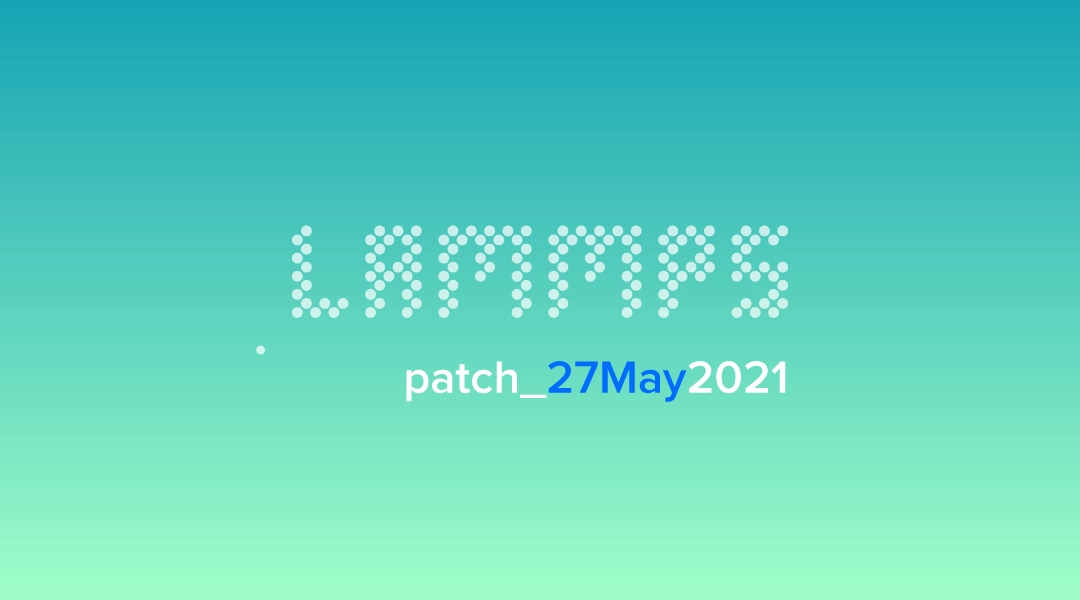
LAMMPS Patch Release Overview
What is LAMMPS used for?
LAMMPS is a classical molecular dynamics (MD) code that models ensembles of particles in a liquid, solid, or gaseous state. It can model atomic, polymeric, biological, solid-state (metals, ceramics, oxides), granular, coarse-grained, or macroscopic systems using a variety of interatomic potentials (force fields) and boundary conditions. It can model 2D or 3D systems with only a few particles up to millions or billions.
LAMMPS can run on single processor laptops or desktops, but is designed for parallel computers using message-passing techniques and a spatial-decomposition of the simulation domain. This includes shared-memory boxes and distributed-memory clusters and supercomputers. Many of its models have versions that provide accelerated performance on CPUs, GPUs, and Intel Xeon Phis. The code is designed to be easy to modify or extend with new functionality.
Interested in getting faster results?
Learn more about LAMMPS Certified GPU Workstations and Servers starting at $4,300
Changes since the 14 May 2021 patch release:
- New package USER-HDNNP which provides a new pair style hdnnp, which is an interface to the N2P2 library for Behler-Parinello neural network potentials (Andreas Singraber, U Vienna) PR #2626
- New package USER-RANN which provides a new pair style
rannand matching potential files for using "rapid atomistic neural network (RANN) potentials (Christopher Barrett and Doyl Dickel, Mississippi State) PR #2570 - Update of the bundled Kokkos library to version 3.4.1 (Stan Moore, SNL and the Kokkos developers) PR #2783
- Update references to the LAMMPS homepage to reference
www.lammps.organddocs.lammps.orginstead oflammps.sandia.govand add tool to check for it and convert such links, also corresponding updates to the LAMMPS manual itself. (Axel Kohlmeyer and Richard Berger, Temple U) PR #2778, PR #2768 - Various small bug fixes, coding style and formatting updates (multiple authors) PR #2640, PR #2770, PR #2771, PR #2772, PR #2773, PR #2775, PR #2776, PR #2777, PR #2781, PR #2782, PR #2784
Backward compatibility notes:
- the LAMMPS home page has been moved from
https://lammps.sandia.govtohttps://www.lammps.org(please report cases where links need to be updated).
This release has 2 assets:
- Source code (zip)
- Source code (tar.gz)
Visit the release page to download them.
About LAMMPS
LAMMPS (Large-scale Atomic/Molecular Massively Parallel Simulator) a classical molecular dynamics simulation code designed to run efficiently on parallel computers. It was developed at Sandia National Laboratories, a US Department of Energy facility, with funding from the DOE. It is an open-source code, distributed freely under the terms of the GNU Public License (GPL).
Have any questions about LAMMPS or other applications for molecular dynamics? Contact Exxact Today

LAMMPS Patch Release 27 May 2021
LAMMPS Patch Release Overview
What is LAMMPS used for?
LAMMPS is a classical molecular dynamics (MD) code that models ensembles of particles in a liquid, solid, or gaseous state. It can model atomic, polymeric, biological, solid-state (metals, ceramics, oxides), granular, coarse-grained, or macroscopic systems using a variety of interatomic potentials (force fields) and boundary conditions. It can model 2D or 3D systems with only a few particles up to millions or billions.
LAMMPS can run on single processor laptops or desktops, but is designed for parallel computers using message-passing techniques and a spatial-decomposition of the simulation domain. This includes shared-memory boxes and distributed-memory clusters and supercomputers. Many of its models have versions that provide accelerated performance on CPUs, GPUs, and Intel Xeon Phis. The code is designed to be easy to modify or extend with new functionality.
Interested in getting faster results?
Learn more about LAMMPS Certified GPU Workstations and Servers starting at $4,300
Changes since the 14 May 2021 patch release:
- New package USER-HDNNP which provides a new pair style hdnnp, which is an interface to the N2P2 library for Behler-Parinello neural network potentials (Andreas Singraber, U Vienna) PR #2626
- New package USER-RANN which provides a new pair style
rannand matching potential files for using "rapid atomistic neural network (RANN) potentials (Christopher Barrett and Doyl Dickel, Mississippi State) PR #2570 - Update of the bundled Kokkos library to version 3.4.1 (Stan Moore, SNL and the Kokkos developers) PR #2783
- Update references to the LAMMPS homepage to reference
www.lammps.organddocs.lammps.orginstead oflammps.sandia.govand add tool to check for it and convert such links, also corresponding updates to the LAMMPS manual itself. (Axel Kohlmeyer and Richard Berger, Temple U) PR #2778, PR #2768 - Various small bug fixes, coding style and formatting updates (multiple authors) PR #2640, PR #2770, PR #2771, PR #2772, PR #2773, PR #2775, PR #2776, PR #2777, PR #2781, PR #2782, PR #2784
Backward compatibility notes:
- the LAMMPS home page has been moved from
https://lammps.sandia.govtohttps://www.lammps.org(please report cases where links need to be updated).
This release has 2 assets:
- Source code (zip)
- Source code (tar.gz)
Visit the release page to download them.
About LAMMPS
LAMMPS (Large-scale Atomic/Molecular Massively Parallel Simulator) a classical molecular dynamics simulation code designed to run efficiently on parallel computers. It was developed at Sandia National Laboratories, a US Department of Energy facility, with funding from the DOE. It is an open-source code, distributed freely under the terms of the GNU Public License (GPL).
Have any questions about LAMMPS or other applications for molecular dynamics? Contact Exxact Today




.jpg?format=webp)